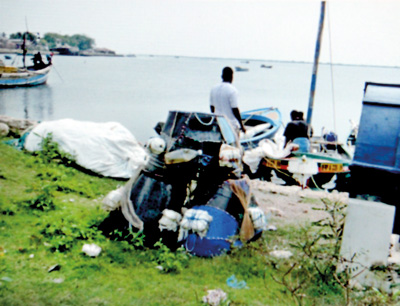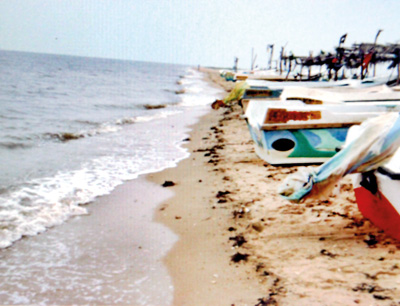News
Fisheries harbour deals: Consultancy firm in hot water
View(s):- Politically connected company alleged to have bloated estimates to get a bigger fee
- Probe reveals irregularities in the award of contract to Power Asia
A politically influential consultancy firm that inflated the estimated cost of three fisheries harbours to secure a multimillion rupee fee has seen its payment sliced by half after an official inquiry. Power Asia Consultants has now been paid just Rs. 92 million of its total Rs. 177 million consultancy fee. Project officials insist that, “despite intense political pressure,” they will not fork out the rest.

Views of fisheries harbour project sites in Gurunagar (left) and Silawathura (right)
In 2014, the company won a contract to conduct feasibility studies and design fisheries harbours in Silawathura, Gurunagar and Gandara. The bid circumstances are in question. The Ministry of Fisheries and Aquatic Resources Development invited a handful of companies to submit proposals. They were allotted just 12 days to do so. It was also specified that the final study must be presented within eight weeks.
“None of the other companies came forward,” said an authoritative source, requesting anonymity. “Not only was there insufficient time to present a serious and competitive bid, a study of this nature could not be delivered in eight weeks. At minimum, it would require six to 8 months.”
Power Asia was “hurriedly” awarded the contract, the source said. Chamath de Silva, the company’s Chairman, however, rejected allegations that he exploited connections with Chathura, the son of Rajitha Senaratne, the then-Minister of Fisheries and Aquatic Resources Development, to clinch the deal.
“We have no connection,” he protested, when contacted by the Sunday Times recently. “We are just friends.” Industry sources say, however, that is not the practice for new companies without prior experience in similar work to be granted such consultancies. According to its own website, Power Asia was only incorporated in 2014.
 Power Asia also lacked in-house expertise, even in part, to professionally undertake the study. It was usual to check a company’s average annual turnover to determine whether it matched the value of the consultancy award. This was not done. Until it was awarded the fisheries harbour study, the firm did not have a registered office. Auditors are now investigating.
Power Asia also lacked in-house expertise, even in part, to professionally undertake the study. It was usual to check a company’s average annual turnover to determine whether it matched the value of the consultancy award. This was not done. Until it was awarded the fisheries harbour study, the firm did not have a registered office. Auditors are now investigating.
In its final report, Power Asia predicted that each harbour would cost around Rs. 6 billion to build. It then sought a massive Rs. 177 million in consultancy fees — or 0.95 percent of the total estimated cost of Rs. 18 billion for three harbours. This bred suspicion that it had grossly inflated the figures to extract higher fees.
The Sunday Times received letters, including one from an official of the Ministry of Fisheries and Aquatic resources Development, saying bills of quantities (BOQ) tabulated by Power Asia for each harbour were unrealistic and inflated. Nevertheless, Kumar de Silva, the former Project Director, made an initial payment of Rs. 46 million to the company.
Following the Government change in January 2015, new Project Director Nihal Somaweera suspended payments and requested the Fisheries Harbour Corporation to review the estimates. A committee studied the respective BOQs and recommended price reductions.
“It was established that certain items were highly overpriced,” said an official source familiar with the committee’s deliberations. “Based on the report of the Fisheries Harbour Corporation, the project office requested an experienced engineer to work out the costs. Many adjustments were made.”
“For instance,” he continued, “the costs of dredging the Silawathura site were reduced to justifiable levels. In all three harbours, the company quoted a very high percentage as ‘preliminary items’. This was cut from 35 per to 10 percent.”The project office has also referred the BOQs to the University of Moratuwa’s Quantity Surveying Division for independent evaluation. Power Asia has so far been paid Rs. 92 million, with the final tranche being handed over on Friday. It is feared the company will take legal action to secure its full fee.
Industry sources argue that even the disbursed amount is far too high. “Their charges were reduced by fifty percent,” said an engineer, who did not wish to be named. “But it is fifty percent of a grossly inflated fee!” (Project officials explain they are bound by the terms of the agreement signed with Power Asia).
The sources also questioned the need for a study in the first place. “Two foreign consultant firms have already done two feasibility studies along with preliminary designs,” said one of them. “The first, by a Danish company, placed the costs at Euros 90 million. The second, by a French company, assessed the costs at Euros 135 million.”
However, the Project Implementation and Monitoring Unit (under the Ministry of Fisheries and Aquatic Resources Development) justified a third study saying the French firm had deviated substantially from the estimates of the Danish company.
“The logical solution would have been to instruct the French company to provide a detailed bill of quantities (BOQ) with breakdown of rates,” said an engineer. “A qualified team could then have reviewed the submission. Instead, it was decided to commission a third study at tremendous cost to the public.”
Power Asia’s report contains extracts from the previous studies. There is no evidence of fresh investigations, such as bathymetric or geotechnical surveys. Moreover, its estimates are similar to that of the French company.
The engineer said it was unusual for a contract to be awarded on a fee based on the value of a preliminary design. “It deviates from all standard norms in the consultancy industry,” he explained. “A percentage of the detailed design is paid when the design is definitive and the costs are accurately known. In a preliminary design, costs are just estimates. The justifiable method is to agree on a lump sum fee.”
Industry experts claimed that the price of Rs. 6 billion per harbour is six to seven times the actual building cost. “The three harbours are to be developed at different scales,” the engineer said. “So the costs should vary substantially from each other. Power Asia, in providing the same estimate for each, seems to have forgotten that.”
For instance, Gandara is a relatively deep harbour, extending to water depths of 8-10 metres. Gurunagar harbour is to be constructed inside lagoon in calm waters and does not require major breakwaters. Only moderate shore infrastructure is needed for smaller boats with inboard engines.
Engineers also agree that some excavation and dredging quantities have been “fictitiously increased by many times”. For example, Silawathura has a basin area of five hectares. Power Asia’s BOQ states the dredging volume at 490,000 cubic metres (costing Rs. 1,300 million).
“Say that 60,000 cubic metres of this is set aside for the navigation channel,” said a senior engineer. “The remaining 430,000 cubic metres of dredging will cause a harbour of 9.5 to 10 metres in depth! But all fisheries harbours in the country have average depth of between three and 3.5 metre water depths.”

